
The energy level diagram of the given element is given below. Identify by doing necessary calculation which transition corresponds to the emission of a spectral line of wavelength 102.7 nm.


Answer
412.5k+ views
Hint: The amount of energy associated with the photon of radiation is directly proportional to the frequency of incident light which is expressed as
Complete answer:
As we know the relation between energy of photon and frequency of incident light is
Where is defined as a universal constant, known as planck's constant. Value of planck's constant is
As we know frequency is also expressed in terms of light constant and wavelength of radiation.
So, final equation of energy in terms of wavelength becomes-
For element A
Therefore, difference in energy is
After solving the above equation, we get
Now calculate the wavelength of transition
After solving this above equation, we get
In terms of nanometer value of wavelength is-
For element B
Therefore, difference in energy is
After solving the above equation, we get
Now calculate the wavelength of transition
After solving this above equation, we get
In terms of nanometer value of wavelength is-
For element C
Therefore, difference in energy is
After solving the above equation, we get
Now calculate the wavelength of transition
After solving this above equation, we get
In terms of nanometer value of wavelength is-
For element D
Therefore, difference in energy is
After solving the above equation, we get
Now calculate the wavelength of transition
After solving this above equation, we get
In terms of nanometer value of wavelength is-
Hence, from the above calculation transition of element D from
Note:
Make sure to convert the wavelength of the radiation into nanometers and convert the unit of
Complete answer:
As we know the relation between energy of photon and frequency of incident light is
Where is defined as a universal constant, known as planck's constant. Value of planck's constant is
As we know frequency is also expressed in terms of light constant and wavelength of radiation.
So, final equation of energy in terms of wavelength becomes-
For element A
Therefore, difference in energy is
After solving the above equation, we get
Now calculate the wavelength of transition
After solving this above equation, we get
In terms of nanometer value of wavelength is-
For element B
Therefore, difference in energy is
After solving the above equation, we get
Now calculate the wavelength of transition
After solving this above equation, we get
In terms of nanometer value of wavelength is-
For element C
Therefore, difference in energy is
After solving the above equation, we get
Now calculate the wavelength of transition
After solving this above equation, we get
In terms of nanometer value of wavelength is-
For element D
Therefore, difference in energy is
After solving the above equation, we get
Now calculate the wavelength of transition
After solving this above equation, we get
In terms of nanometer value of wavelength is-
Hence, from the above calculation transition of element D from
Note:
Make sure to convert the wavelength of the radiation into nanometers and convert the unit of
Recently Updated Pages
Master Class 12 Business Studies: Engaging Questions & Answers for Success

Master Class 12 English: Engaging Questions & Answers for Success

Master Class 12 Social Science: Engaging Questions & Answers for Success

Master Class 12 Chemistry: Engaging Questions & Answers for Success

Class 12 Question and Answer - Your Ultimate Solutions Guide

Master Class 11 Business Studies: Engaging Questions & Answers for Success

Trending doubts
Draw a labelled sketch of the human eye class 12 physics CBSE

a Tabulate the differences in the characteristics of class 12 chemistry CBSE

Which one of the following is a true fish A Jellyfish class 12 biology CBSE

Why is the cell called the structural and functional class 12 biology CBSE

Differentiate between homogeneous and heterogeneous class 12 chemistry CBSE

Write the difference between solid liquid and gas class 12 chemistry CBSE




